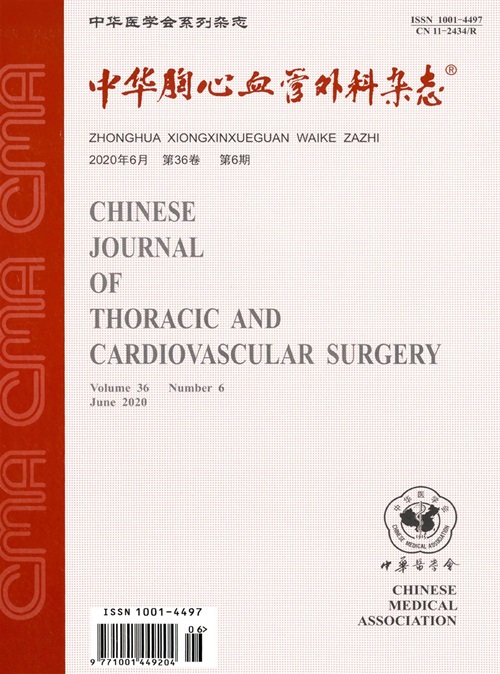Totally robotic atrial septal defect closure using da vinci S surgical system on beating heart
引用次数: 1
Abstract
Objective To Summary the first 40 cases underwent robotic atrial septal defect (ASD) closure or atrial septal defect closure combined bicuspid valve plasty (TVP) using "da Vinci S" surgical System on beating heart. Methods 40 cases of atrial septal defect or combined sever tricuspid valve regurgitation were repaired using "da Vinic S" surgical system on beating heart from March 2009 to December 2010 in cardiovascular department of PLA general hospital. The average age was (38 ± 13) yeas old. 23 cases were female and 17 cases were male. All patients were ostium atrial septal defect with or without pulmonary hypertension. The atrial defect diameter was 1.5 -3.5 cm, and the mean diameter was(2. 8 ±1.3)cm. 9 patients had sever tricuspid valve regurgitation. Without sternotomy, the extracorporeal circulation was established through groin artery,groin vein and internal jugular vein cannulation with the guidance of transeophageal echocardiography. 3 ports of 8 mm and 1 working port of 2 cm were made in the right chest wall. After "da Vinci S" syetem was set up, with the assistant of bed-side surgeon, the surgeon completed the atrial septal defect closure or combined tricuspid valve plasty in the surgeon console with three dimensions visualization. During the operation, without cardioplegia administrated and aortic occlusion, the procedure was completed through right atriotomy. The pleural space was insufflated with carbon dioxide to avoid the air embolism. The direct suturing was used in 22 cases and pericardial patch were used in 18 cases. 9 patients accepted concurrent De Vega tricuspid valve plasty. The transesophageal echocardiography were used to evaluate the result of atrial defect closure or tricuspid valve repair. The operation time, robotic using time and cardiopulmonary time were compared with totally robotic atrial defect repair in arrested heart. Results All cases were accomplished successfully without complication. There was no residual shunt and air embolism. The operation time, robotic using time and cardiopulmonary time were less than the arrested group. Conclusion Robotic atrial septal defect closure or combined tricuspid valve repair on beating heart can avoid aortic ocllusion and can be utilized effectively and safely. Key words: Atrial septal defect; Cardiac Surgical procedures; Minimally invasive; Robotics用达芬奇S手术系统对跳动心脏进行全机器人房间隔缺损闭合
目的总结采用“达芬奇S”手术系统对跳动心脏进行机器人房间隔缺损(ASD)闭合或房间隔缺损闭合联合双尖瓣成形术(TVP)的40例病例。方法对2009年3月至2010年12月解放军总医院心血管科40例房间隔缺损或合并严重三尖瓣返流患者采用“da - Vinic - S”系统对跳动心脏进行修复。平均年龄(38±13)岁。其中女性23例,男性17例。所有患者均为口房间隔缺损,伴或不伴肺动脉高压。心房缺损直径1.5 ~ 3.5 cm,平均直径为(2)cm。8±1.3)厘米。严重三尖瓣反流9例。不开胸,在经食管超声心动图引导下,通过腹股沟动脉、腹股沟静脉及颈内静脉插管建立体外循环。右胸壁造3个8mm口和1个2cm工作口。“达芬奇S”系统建立后,在床边外科医生的协助下,外科医生在外科手术台上三维可视化完成房间隔缺损闭合或联合三尖瓣成形术。术中,无心脏截瘫和主动脉阻塞,手术通过右心房切开完成。胸膜腔内注入二氧化碳以避免空气栓塞。直接缝合22例,心包补片18例。9例患者同时接受De Vega三尖瓣成形术。经食管超声心动图评价心房缺损闭合或三尖瓣修复的效果。比较全机器人心房缺损修复与全机器人心房缺损修复的手术时间、机器人使用时间和心肺时间。结果所有病例均顺利完成手术,无并发症。没有残留的分流和空气栓塞。手术时间、机器人使用时间、心肺时间均低于停搏组。结论机器人心房间隔缺损封闭或联合三尖瓣修复心脏跳动时可避免主动脉堵塞,可安全有效地应用。关键词:房间隔缺损;心脏外科手术;微创;机器人
本文章由计算机程序翻译,如有差异,请以英文原文为准。
求助全文
约1分钟内获得全文
求助全文
来源期刊
CiteScore
0.20
自引率
0.00%
发文量
6779
期刊介绍:
The Chinese Journal of Thoracic and Cardiovascular Surgery is an academic journal sponsored by the Chinese Medical Association. It mainly publishes original research papers, reviews and comments in this field. The journal was founded in 1985 and is included in well-known databases such as the CSCD Chinese Science Citation Database Source Journals (including extended versions) and the Statistical Source Journals (China Excellent Science and Technology Papers Journals). It is one of the national key academic journals under the supervision of the China Association for Science and Technology. The Chinese Journal of Thoracic and Cardiovascular Surgery enjoys a high reputation and influence in the academic community. The articles published in the journal have a high academic level and practical value, providing readers with a large number of practical cases and industry information, and have received widespread attention and citations from readers.

 求助内容:
求助内容: 应助结果提醒方式:
应助结果提醒方式:


